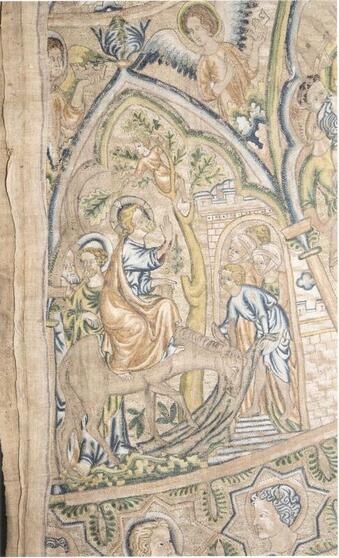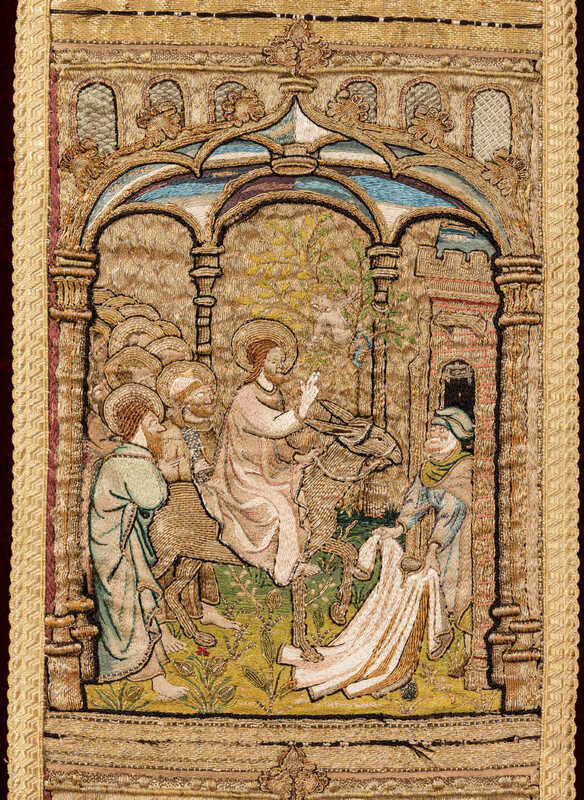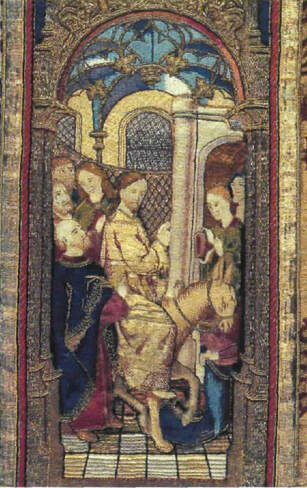|
Sometimes a question pops up in my mind in the middle of the night. These questions usually develop into delightful rabbit holes the next day. My latest 'in the middle of the night question' concerned the embroidered depiction of Palm Sunday. You see, some scenes were hugely popular in the medieval period, and we have many embroidered depictions of them. And then you have scenes that are very rare. Palm Sunday turns out to be one of these rare scenes. By now, I have looked at over 1650 pieces of medieval goldwork embroidery. That's about 4480 orphreys. Only three (!) of those depict the Triumphal entry into Jerusalem. But those three have a rather interesting story to tell. Let's hop down the rabbit hole! Two of the three orphreys depicting the Triumphal entry into Jerusalem look very, very similar. Above on the left is the scene as depicted on the Bologna cope. This is a famous cope made in the style of Opus anglicanum and it dates to the early 14th century. On the right, you see an orphrey on the chasuble of a Belgian bishop who reigned around the middle of the 15th century. That one was made between about 133 and 157 years later. Yet, the compositions of both scenes are eerily similar. Only the clothing of the Jerusalem citizen spreading a garment onto the street has adapted to the correct fashion of the time. Fascinating, isn't it? I think that both embroideries are based on the same image. Maybe from a famous illuminated manuscript or from a painting in a church. An image that was clearly widely known in Western Europe in the 14th and 15th centuries. Both embroideries are also testimony that the embroidery techniques can be very different and still produce two very similar pictures. Do click on the image on the right as it will take you to the KIK-IRPA database with many more pictures of the chasuble of bishop Chevot. The third image is clearly different. It comes from a chasuble belonging to an ornate associated with bishop David of Burgundy of Utrecht in the Netherlands. The chasuble is now kept in the Cathedral treasury of Liege. Gone is the delightful chap sitting in the tree. And the Jerusalem street is suddenly paved. Interestingly, this chasuble was made around the same time as the chasuble of bishop Chevot. However, although now both chasubles are kept in Belgium, originally the one made for bishop David of Burgundy was made in the Northern Netherlands. Possibly in Utrecht, his bishopric see.
The Opus anglicanum piece has obviously no or nue. The orphrey made in the Southern Netherlands (bishop Chevot) has a kind of rudimentary or nue in the donkey and for the house/gate of Jerusalem. Contrary, the orphrey made in the Northern Netherlands (bishop David of Burgundy) has Jesus completely rendered in very fine or nue. Throughout the orphreys on this chasuble, Jesus is the only figure wearing clothing (partly) stitched in or nue. That's just in case an onlooker missed who was the most important figure in the embroidered story. The question remains: why is this particular scene so rare in medieval goldwork embroidery? Did embroiderers not like to stitch donkeys? They seem to do okay-ish when it comes to the Nativity. Was it a part of the Passion story that did not appeal so much to Joe Average medivialis? I do not know enough about medieval liturgy to determine if Palm Sunday was perhaps less significant back than? Or maybe other parts of the Passion were just more popular and appealed more? Trying to get into the heads of people who lived more than 700 years ago is fun, but never quite satisfactory!
17 Comments
Natalie
3/4/2023 17:06:50
As usual Jessica, you have such fun information to share. Enjoy the diaper work, after finding it so hard at start to remember the pattern repeats I now enjoy doing them slowly over time. Your red and gold looks wonderful.
Reply
3/4/2023 17:54:53
I was demonstrating this on Saturday and I was again amazed how many people could not understand the principle. They thought that I was a very precise and regular stitcher :).
Reply
Your blogs are always very interesting and stimulating reading, this one is also very thought-provoking.
Reply
3/4/2023 17:56:44
Thank you, Andrejka! Hmm, many other depictions of Christ would then be problematic too. His lowly birth and all the different scenes of the Passion. They do not depict a victorious or power-hungry Church.
Reply
4/4/2023 17:17:52
I had a word with one of the professionals from next door (Pater Michael of Ettal Abbey). He mused that this scene might be a bit disruptive when you look at the sequence from birth to crucifixion. It is simply too happy and might distract from contemplation on the Passion.
Reply
Agnė
3/4/2023 21:19:05
Thank you for your interesting post. Now I want to google and search more embroidered entrances to Jerusalem :D
Reply
4/4/2023 08:32:05
That's an interesting thought, Agne. However, the Schism occured in the 11th-century and we see depictions starting to differ from the Byzantine depictions quite quickly. This is well documented for for instance the Nativity. We also know from legal documents that embroidery workshops often had a book like the Legenda Aurea to make sure they depicted things faithfully. I've also looked at orthodox icons and although some elements are similar, the overall composition is different from the embroideries.
Reply
Agnė
3/4/2023 21:27:49
And about that child in the tree: he is one of the "pueri Hebraeorum", who are breaking off branches from the palms and laying them before Christ’s donkey (portantes ramos olivarum). This is how they are explained in the Eastern tradition (sometimes there are more of them in the tree) .
Reply
4/4/2023 08:34:11
Yes, medieval artists were good at adding details that cannot be directly found in the bible. It was their way to try to get as close to the stories as they could. A famous one is the pensive Christ.
Reply
NancyB
4/4/2023 09:45:46
What an interesting question. I wonder if we'll ever know the answer?
Reply
4/4/2023 09:54:00
Good observations, Nancy! I had noticed that Jesus was riding side-saddle in the oldest piece. And I am wondering if this is significant? As always, rabbit holes galore :).
Reply
Elina G
4/4/2023 15:33:14
Jesus's long clothes would have had to be very wide to be able to sit straddled without showing an unseemly amount of leg and I suppose it also adds to the image of arriving humbly on a donkey as a Prince of peace sitting in a position not practical when doing militay business. 4/4/2023 17:15:41
Good point, Elina! Being poor, his mantle was likely not so voluminous to allow anything else as side-saddle.
Reply
6/4/2023 16:35:42
Yes, Rachel, medieval people were very good at concentrating on the negative when it came to the life of Jesus or the Saints. They even invent more instruments of the Passion to add to the gruesome story.
Reply
Rebecca
12/4/2023 16:34:07
Fascinating rabbit hole! Thank you, Jessica, and all of you insightful commenters.
Reply
Your comment will be posted after it is approved.
Leave a Reply. |
Want to keep up with my embroidery adventures? Sign up for my weekly Newsletter to get notified of new blogs, courses and workshops!
Liked my blog? Please consider making a donation or becoming a Patron so that I can keep up the good work and my blog ad-free!
Categories
All
Archives
July 2024
|
Contact: info(at)jessicagrimm.com
Copyright Dr Jessica M. Grimm - Mandlweg 3, 82488 Ettal, Deutschland - +49(0)8822 2782219 (Monday, Tuesday, Friday & Saturday 9.00-17.00 CET)
Impressum - Legal Notice - Datenschutzerklärung - Privacy Policy - Webshop ABG - Widerrufsrecht - Disclaimer
Copyright Dr Jessica M. Grimm - Mandlweg 3, 82488 Ettal, Deutschland - +49(0)8822 2782219 (Monday, Tuesday, Friday & Saturday 9.00-17.00 CET)
Impressum - Legal Notice - Datenschutzerklärung - Privacy Policy - Webshop ABG - Widerrufsrecht - Disclaimer









 RSS Feed
RSS Feed